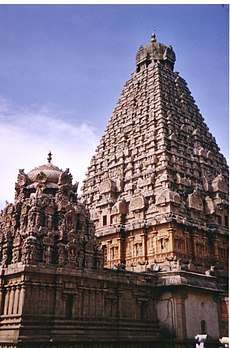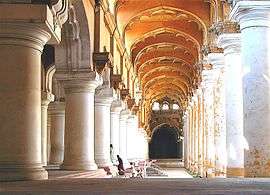Madurai Nayak dynasty
The Madurai Nayaks were Tamil rulers[1] from around 1529 until 1736, of a region comprising most of modern-day Tamil Nadu, India, with Madurai as their capital. The Nayak reign was an era noted for its achievement in arts, cultural and administrative reforms, revitalization of temples previously ransacked by the Delhi Sultans, and inauguration of a unique architectural style.
Madurai Nayak dynasty | |
|---|---|
| 1529–1736 | |
 Approximate extent of the Madurai Nayak Kingdom, circa 1570. | |
| Capital | Madurai (1529–1616) Tiruchirapalli (1716–1736) |
| Common languages | Tamil, Telugu |
| Government | Governors, then Monarchy |
| History | |
• Established | 1529 |
• Disestablished | 1736 |
Preceding States
|
Succeeding States
|
Breakaway States |
| Part of a series on |
| History of Tamil Nadu |
|---|
 |
|
Medieval history
|
|
Categories
|
The dynasty, belonging to the Balija social group, consisted of 13 rulers, of whom 9 were kings, 2 were queens, and 2 were joint-kings. The most notable of these were the king, Tirumala Nayaka, and the queen, Rani Mangammal. Foreign trade was conducted mainly with the Dutch and the Portuguese, as the British and the French had not yet made inroads in the region.
History
| Kings and Queen Regents of Madurai Nayak Dynasty | |
|---|---|
| Part of History of Tamil Nadu | |
 | |
| Madurai Nayak rulers | |
| Viswanatha Nayak | 1529–1563 |
| Kumara Krishnappa Nayak | 1563–1573 |
| Joint Rulers Group I | 1573–1595 |
| Joint Rulers Group II | 1595–1602 |
| Muttu Krishnappa Nayak | 1602–1609 |
| Muttu Virappa Nayak | 1609–1623 |
| Tirumalai Nayak | 1623–1659 |
| Muthu Alakadri Nayak | 1659–1662 |
| Chokkanatha Nayak | 1662–1682 |
| Rangakrishna Muthu Virappa Nayak | 1682–1689 |
| Rani Mangammal‡ | 1689–1704 |
| Vijaya Ranga Chokkanatha Nayak | 1704–1731 |
| Queen Meenakshi‡ | 1731–1736 |
| ‡ Regent Queens | |
| Capitals | |
| Madurai | 1529–1616 |
| Tiruchirapalli | 1616–1634 |
| Madurai | 1634–1665 |
| Tiruchirapalli | 1665–1736 |
| Major forts | |
| Madurai 72 Bastion Fort | |
| Tiruchirapalli Rock Fort | |
| Dindigul Fort | |
| Thirunelvelli Fort | |
| other Military forts | |
| Namakkal Fort | |
| Sankagiri Fort | |
| Attur Fort | |
| Palaces | |
| Thirumalai Nayak Mahal, Madurai | |
| Chokkanatha Nayak Palace a.k.a. Durbar Hall, Tiruchirapalli | |
| Rani Mangammal Tamukkam palace Madurai | |
Viswanatha Nayaka
Viswanatha's chief minister, Ariyanatha Mudaliar, assisted him in using the palayam or poligar system which was widely used to govern the Nayak kingdom. The system was a quasi-fedual organisation of the country, which was divided into multiple palayams or small provinces; and each palayam was ruled by a palayakkarar or a petty chief. Ariyanatha organized the Pandyan kingdom into 72 palayams and ruled over the 72 dry-zone poligar chiefs.[5]
The Meenakshi Temple, destroyed by the Mohammedans was re-constructed in 1569. At the entrance of the Thousand Pillar Mandapam, we can still see the statue of Ariyanatha Mudaliar seated on a beautiful horse-back which flanks one side of the entrance to the temple. The statue is still periodically crowned with garlands by modern worshippers. He lived until 1600 and had great influence upon the fate of the Nayaka dynasty until his death.[6]
| Outline of South Asian history | ||||||||||||||||||||||||||||||||||||||||||||
|---|---|---|---|---|---|---|---|---|---|---|---|---|---|---|---|---|---|---|---|---|---|---|---|---|---|---|---|---|---|---|---|---|---|---|---|---|---|---|---|---|---|---|---|---|
_without_national_boundaries.svg.png) | ||||||||||||||||||||||||||||||||||||||||||||
|
Palaeolithic (2,500,000–250,000 BC) |
||||||||||||||||||||||||||||||||||||||||||||
|
Neolithic (10,800–3300 BC)
|
||||||||||||||||||||||||||||||||||||||||||||
|
Chalcolithic (3500–1500 BC)
|
||||||||||||||||||||||||||||||||||||||||||||
|
Bronze Age (3300–1300 BC)
|
||||||||||||||||||||||||||||||||||||||||||||
|
Iron Age (1500–200 BC)
|
||||||||||||||||||||||||||||||||||||||||||||
|
Middle Kingdoms (230 BC – AD 1206) |
||||||||||||||||||||||||||||||||||||||||||||
|
Late medieval period (1206–1526)
|
||||||||||||||||||||||||||||||||||||||||||||
|
Early modern period (1526–1858)
|
||||||||||||||||||||||||||||||||||||||||||||
|
Colonial states (1510–1961)
|
||||||||||||||||||||||||||||||||||||||||||||
|
Periods of Sri Lanka
|
||||||||||||||||||||||||||||||||||||||||||||
|
Specialised histories |
||||||||||||||||||||||||||||||||||||||||||||
Descendants of Vangaru Thirumalai
Nayakas of Kandy
Some of the family members of Vangaru Thirumalai established the Nayak dynasty in Sri Lanka known as the Kandy Nayaks. They ruled till 1815 with Kandy as their capital and were also the last ruling dynasty of Sri Lanka. The Kings of Kandy had from an early time sought and procured their wives from Madurai. The Kandy Nayaks received military support from the Nayaks of Madurai in fighting off the Portuguese. And in the 17th and 18th centuries, marital alliances between the Kandyan kings and Nayak princesses had become a matter of policy.[10]
Nayaka coins
Some early Madurai Nayaka coins portray the figure of the king. The bull also is seen frequently on the Madurai Nayak coins. Chokkanatha Nayak, one of the last rulers of the dynasty, issued coins displaying various animals, such as the bear, elephant and lion. He also issued coins featuring Hanuman and Garuda. The inscriptions on the Nayak coins are in Tamil, Telugu, Kannada, and Nagari scripts. Unlike the coins of many of the earlier dynasties, the Nayak coins are easily available for coin-collectors.[11]
References
- Howes, Jennifer (1 January 1998). The Courts of Pre-colonial South India: Material Culture and Kingship. Psychology Press. p. 28. ISBN 07-0071-585-1.
- Religion in Vijayanagara Empire, by Konduri Sarojini Devi, p.100 mentions: "Granting that Acyuta conferred on Visvanatha the kingship of the Pandya Mandalam as Father Heras believes, it is possible that Visvanatha changed his faith to Vaishnavism to suit the exigencies. According to the Kaifiyat of the Karnata Kotikam Kings, "Acyutadeva Maharaya formally crowned Visvanatha Nayadu of the Garikepati family of the Balija caste as the King of Pandya country yielding a revenue of 2 and 1/2 crores of varahas..
- Rao, Velcheru Narayana; Shulman, David; Subrahmanyam, Sanjay (1998). Symbols of substance : court and state in Nayaka period Tamil Nadu. Oxford University Press. p. 10.
Originally part of the great Telugu migrations southward into the Tamil country in the 15th and 16th centuries, the Balija merchant- warriors reveal the rise of hitherto marginal, and only recently politicized.. These mobile, aggressive, land-hungry, Telugu-speaking warriors....helped to build the Nāyaka state-system and to impregnate it with their particular cultural vision; strong surviving traditions; supported by contemporary evidence, assert Balija origins and / or marital connections for the major Nāyaka dynasties in the Tamil country quite apart from the well-known Balija role in restructuring the revenue systems of Nāyaka Tanjavur and Madurai
- Irschick, Eugene F. Politics and Social Conflict in South India, p. 8: "The successors of the Vijayanagar empire, the Nayaks of Madura and Tanjore, were Balija Naidus."
- Bayly, Susan (2004). Saints, Goddesses and Kings: Muslims and Christians in South Indian Society, 1700–1900 (Reprinted ed.). Cambridge University Press. p. 48. ISBN 978-0-52189-103-5.
- History&Description of Sri Meenakshi Temple, by T. G. S. Balaram Iyer, T. R. Rajagopalan
- Gordon Johnson, John F. Richards, Christopher Alan Bayly (1987). https://books.google.com/books?id=aHcfv6zkJgQC. Cambridge University Press. ISBN 9780521563215. External link in
|title=(help)CS1 maint: multiple names: authors list (link) - History of Tirumala Nayaka, by K.Rajaram, p.27-31
- History of Tamilnad, Volume 2, by N. Subrahmanian, p.282.
- Trawick, Margaret (2007). Enemy lines: childhood, warfare, and play in Batticaloa. University of California Press. p. 40. ISBN 978-0-52093-887-8.
- "The Hindu : Crafted coins". The Hindu. India. Retrieved 14 June 2008.
External links
| Wikimedia Commons has media related to Madurai Nayak Dynasty. |
- Images of Nayak kings
- The Hindu : Crafted coins
- Namma Madurai: From Vedas to military strategies – The Hindu
- Images of Nayak kings found in Sri Nellaiyappar Temple – TAMIL NADU – The Hindu
- Thirumalai Nayak period inscription found at temple – The Hindu
- "Madurai City Chronicles : Unique in its own way". The Hindu. Chennai, India. 4 August 2007. Retrieved 14 June 2008.
- "Vanishing wall paintings". The Hindu. India. Archived from the original on 16 September 2009. Retrieved 14 June 2008.